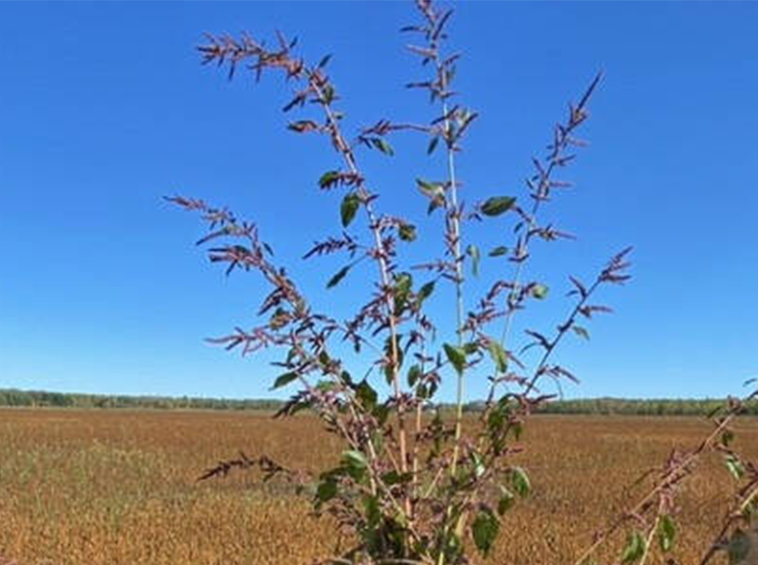
Updated Manitoba Agriculture Information re: Waterhemp and How it is to be Managed
Waterhemp (Amaranthus tuberculatus) is a summer annual broadleaf weed that is a member of the pigweed family. Originally from south central United States, waterhemp has been spreading north and west in agricultural fields. Waterhemp is an aggressive, fast-growing, and highly adaptable weed that poses significant challenges to crop production in Manitoba as it has developed resistance to most commonly used herbicide groups. Five way resistance to groups 9, 2, 5, 14, and 27 develops rapidly. Row crops such as soybeans, dry beans, corn and sunflowers are most impacted by waterhemp competition.
Biology
- Summer annual, germinates in late spring and continues emerging throughout the growing season, even post harvest.
- Can grow up to 2.5 cm per day under optimal conditions.
- Dioecious (separate male and female plants), promoting genetic diversity and rapid adaptation.
- Each plant can produce up to 4.8 million seeds per season under ideal conditions.
- Seeds are small (less than 1 mm), facilitating spread via water, wind, animals, equipment, and contaminated seed or feed.
There are many different pigweeds in Manitoba. Some are common agricultural weeds such as red root pigweed, powell’s or green pigweed and tumble pigweed. Waterhemp, smooth pigweed, and Palmer amaranth are more problematic species and are more difficult to control, so proper identification is important.
Waterhemp Identification – See Waterhemp Factsheet
Waterhemp Management
Waterhemp is currently classified as a Tier 1 and Tier 2 Noxious weed in Manitoba depending on the Rural Municipality (RM) and when found requires immediate action for removal.
In Manitoba, waterhemp is classified as a Tier 1 noxious weed in the following RMs: All areas of the province outside the Municipalities of Emerson-Franklin, Norfolk-Treherne, North Norfolk, Rhineland, Westlake-Gladstone and the Rural Municipalities of Brokenhead, Dauphin, De Salaberry, Dufferin, Ellice-Archie, Grey, Hanover, Lac du Bonnet, Macdonald, Montcalm, Morris, Piney, Reynolds, Ritchot, Roland, St. Andrews, Ste. Anne, St. Clements, Springfield, Stanley, Stuartburn, Tache and Whitemouth
Waterhemp is classified as a Tier 2 noxious weed in the following RMs: Emerson-Franklin, Norfolk-Treherne, North Norfolk, Rhineland and Westlake-Gladstone and the Rural Municipalities of Brokenhead, Dauphin, De Salaberry, Dufferin, Ellice-Archie, Grey, Hanover, Lac du Bonnet, Macdonald, Montcalm, Morris, Piney, Reynolds, Ritchot, Roland, St. Andrews, Ste. Anne, St. Clements, Springfield, Stanley, Stuartburn, Tache and Whitemouth.
Responsibility to Destroy or Control Noxious Weeds (as per Regulation)
3(1) A person must
(a) destroy all tier 1 noxious weeds that are on land that the person owns or occupies;
(b) destroy all tier 2 noxious weeds that are on land that the person owns or occupies if the area
colonized by the weeds is less than twenty acres;
(c) control all tier 2 noxious weeds that are on land that the person owns or occupies if the area
colonized by the weeds is twenty acres or more; and
(d) control a tier 3 noxious weed that is on land that the person owns or occupies if the weed’s
uncontrolled growth or spread is likely to negatively affect an aspect of Manitoba’s economy or
environment in the area of the land or the well-being of residents in proximity to the land.
Waterhemp Regulation
- Confirmed in 28 rural municipalities in Manitoba, as of 2024 (as identified above)
- Downgraded to a Tier 2 weed in those rural municipalities.
– Small infestations must still be destroyed.
– Larger, field-wide infestation must be controlled.
- Remains a Tier 1 in rural municipalities where it has yet to be found.
- Pull or dig up plants with roots intact and remove from field.
- Do not cut or put plants through combine.
Controlling Waterhemp requires using all the tools in the weed control toolbox.
- Diverse crop rotation with competitive crops in the mix.
- Use of narrow row spacing.
- Use of strategic tillage.
- Use of pre -and post- emergent products with multiple modes of action.
- Harvest weed seed control to prevent seed from spreading in the field through the use of chaff lining, chaff tramlining, bale direct, chaff wagons or weed seed destructors on combine.
For detailed RM information with respect to the designation of various weeds see the Noxious Weeds list.
Legislation
Controlling Noxious Weeds FAQs
Waterhemp and the Noxious Weeds Act (video)
Additional Resources
Patrolling for Waterhemp and other herbicide resistant pigweeds (video)
– Originally posted July 7, 2025 with information via Manitoba Agriculture. Photo: Kim Brown/Manitoba Agriculture



